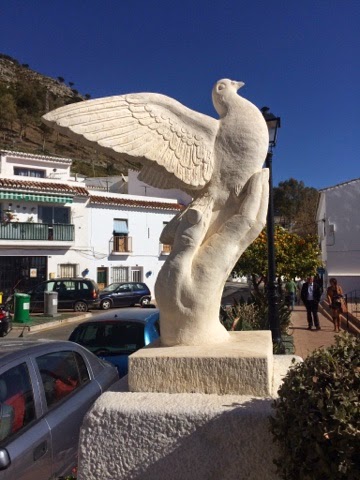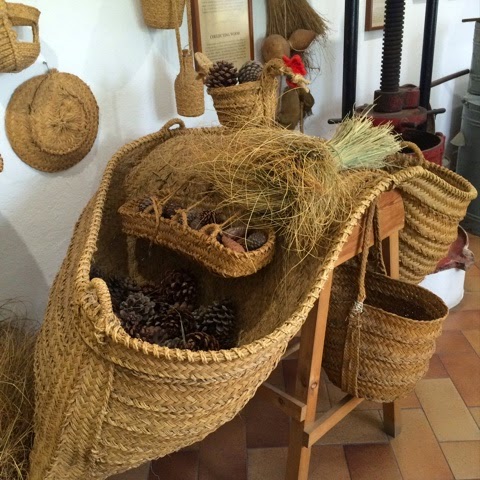We took a weekend off while we are here in Torremolinos. Many of you think of us as on holiday. But when you spend two months in the same place, cooking many of your own meals, it feels like home so a weekday jaunt to see another part of the area is reasonable.
Mijas is an hour by bus from Torremilinos, up a hillside. It's a local bus thoug,h so it cost the same as if we were taking a bus into the centre of town from where we live, €1.65.
Here is a dramatic statue of a dove being released. A dove of peace. Of course.
The town is up high, but you can still see the Mediterranean Sea.
This map of the village in ceramic tile gives you a sense of the layout. The town is on top of a hill for safety. The residents could defend themselves from mauraders. The town was also walled with some fortifications.
The streets are narrow, all the houses are white but the buildings are festooned with these blue pots with geraniums to add colour. The white villages of this area of Spain are quite famous. This is the one closest to us.
We stayed in a little apartment in the village. These bright chairs were on the shared interior patio.
Breakfast in the morning was taken at this panaderia, a bakery café across the street, which opened in 1904.
There were many tourist shops as this village is inundated with the hordes every day via buses that bring them from the coast. This shop featured Picasso taking a rest from painting outside.
In another square is this statue which features a proud resident showing the backbreaking nature of their work before the tourists brought their money.
Geordie met this guy and they immeciately hit it off. It seems a mutual attraction.
Around the edge of town are some walking areas with views to other parts of the town as well as distant views.
That's Fuengirola down there. It's only 8 kms but seems a world away.
And from this vantage point one can see Africa. It's visible as a darker blue line above the sea, although not really discernible here.
Here are some remains of the wall that would have stretched round the town long ago.
Back at our patio we enjoyed time reading in the sunshine.
In the morning we heard the bells from this church which was at the end of our street. It's dedicated to Saint Sebastian although there appeared to be no statue of him.
This is the interior. It's quite a small church.
A little relief from the whitewashed buildings.
One of the many handcrafts practiced by the locals in times past was plaiting straw for practical use. Now artisans make more decorative items for the tourist trade. This horse and sheep being case in point.
Another crafted sheep.
We did not stop in at the Cave Bar, but loved the door. There was actually another door of more normal size for the Elves and Northmen of Middle Earth, as well as this one for the Hobbits.
Hmmm, hill village means hills. And hill streets.
And narrow streets with twists and turns.
Although this elegant curve of buildings is less forbidding.
Transportation in the past was by horse and donkey. Now tourists get to take photos of them. And have carriage rides. There were quite a lot of Japanese and Chinese tourists in town we noticed.
Another view from high up.
Here's some more of the old wall.
We toured the bull fighting ring which is at one of the highest points in town. The president of the bull fight organization sat up there.
Note that one buys tickets to watch the fights in Sombra (shade) or Sol (sun). Sombra costs more, naturally.
A bull fighter in his "suit of lights".
And another practicing. Surprisingly, the cape is very heavy. I had no idea that it would be weighted.
Here's where the bullfighters hide when the bull gets a little too feisty. Really, the fighters have the easy job. There's nowhere for the bull to hide.
Before going into the ring, the Matadors stopped at this tiny chapel to pray. Again, there is nowhere for the bull to ask for protection. And as an aside, although bull-fighting still occurs in this part of Spain, it has been banned in other areas.
We had a look at the local Ethnographic museum which had scenes and objects of village life. This large grinder is where olives were crushed to make that extra virgin olive oil. The red contraption on the left contained a large screw (auger) which turned, bringing olives onto the hopper to fall on the stone grinding surface.
Here is a straw donkey pressed into service to operate another mill.
The much more practical uses of the straw weaving industry. These panniers would sit across the back of a donkey to carry goods up and down hills and in and out of the fields. Those donkeys worked hard.
Loved these local handmade sandals. Really fine work.
Another of Mijas'attractions is a small contemporary art museum. They are proud to be the second largest museum collection of Picasso ceramics. (The first is in France).
Picasso did a large number of ceramic pieces later in life. Hmm, perhaps this is a portrait of Salvador Dali.
He had a fascination for bulls.
And bull-fighting. This is not ceramic, but a carving on a small rock about 2 inches in diameter, showing a picador (the guy at the bull fight who lances the poor beast to weaken it so the matador has the advantage).
Picasso also had a passion for owls. This is one of several pots and jugs he decorated with owl figures.
Here a platter showing more bull fight scenes.
There was a great viewing patio on the roof of the museum where we got a bird's eye view of the streets.
And downstairs Picasso sits in his corner contemplating all the visitors who come to see his work.
At the tourist office, a little colour.
The patron saint of Mijas is La Virgen de la Pena. She is in this castle-like structure reached by a ramp across a small gorge.
She will be carried through the streets on special days.
Here, around a corner, another odd boy figure. I think those are golden wings.
There was a small display of ecclesiastical robes, done in heavy gold embroidery.
Outside was the Donkey Taxi rank. We did not take a ride. Note, donkey areas smell just like horse barns.
What's a blog from me without food. We found a very creative tapas bar our last evening in town. The town was very quiet and unlike other towns, many of the restaurants were closed early. This is a shrimp wrapped in thin potato strips and deep fried. And a sweep of reduced balsamic vinegar.
A piece of bacalao and tomato under a cloak of bechamel served on a slate. With the name of the bar in pimentón (smoked paprika).
Two delicious mushroom croquetas.
And the thing we ordered which we didn't need. This version of huevos rotos (broken eggs) was a piping hot casserole filled with French fries, fabulous wild mushrooms and two eggs baking underneath in the heat from the potatoes. Oh, and shrimp. Because. I know, it's a lot like poutine, but with those mushrooms? Over the top.
The bus ride up was packed, with the entire aisle full with standees. They were most likely doing a day trip instead of an overnight. The 10 am ride down was easy.
And there you have our little vacation, in pictures. As we head for home.
These flowers are your last image. They are along our street and we pass them every day. I love their colour. Spring is in the air.

























































Enjoyed, as always. Not a big fan of bull fighting, but it is what it is and I suppose it's sort of like the Stampede and rodeo in North America.
ReplyDelete